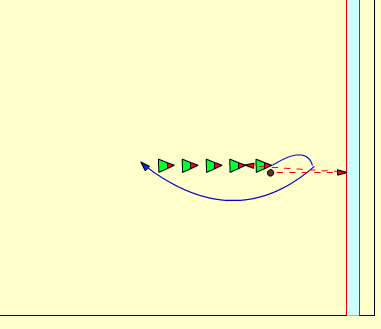Handball drills
- Right corner player runs towards the outside defender on the other side and puts a back barrage.
- Left build-up with ball threatens on the 2nd defender.
- Makes a threat and jumps to the middle and plays to the blocking player or shoots at goal himself
- Optionally, the ball can also be played into the circle if the middle defender gets out/closes up.
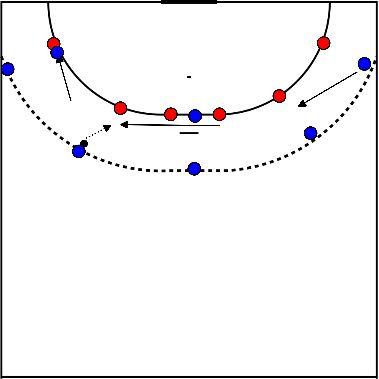
- 2 teams divided over the right and left corner.
- 1 defender between the halfway line and the 9 meter who tries to intercept.
- One of the teams passes to the goalkeeper.
- The goalkeeper plays one of the team around the halfway line.
- The duo tries to outplay the attack and scores on goal.
- After scoring, grab the ball and stay on that side.
- The same is done on the other goal.
- As a variation, you can put 2 defenders down to make it more difficult.
- You can make it more difficult by telling them they cannot bounce.
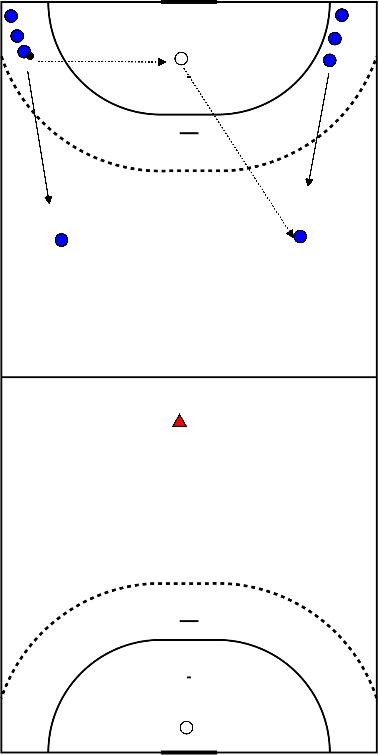
- Put a goal or put a mat in front of it and make compartments with tape or in some other way.
- Give the divided squares points.
- Each player may throw 3 times.
- Keeping track of the points and adding them up
- Player starts at the pylon in the middle.
- Sprints to the left pylon.
- Picks up the ball and works it towards the goal.
- Player sprints back to the pylon in the middle.
- Now sprints to the right pylon.
- Picks up the ball and finishes on the goal.
- Player sprints back to the centre pylon.
- Sprints to the second pylon on the left.
- Finishes with the goal.
- Player sprints back to the centre pylon.
- Sprints to the second pylon on the right.
- Finishes with the goal.
- The other players remain in their places, dribbling
- Or they can do strength training
- Jumping rope
- Dribble with the ball in a square.
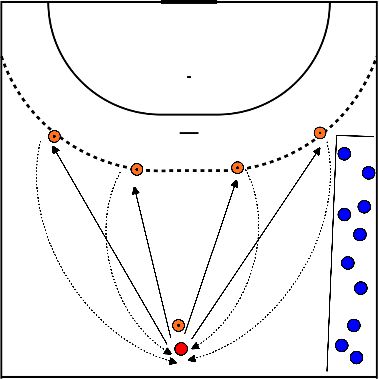
- Ball goes from the left tackle to the middle tackle.
- The middle build-up breaks away and throws the ball to the incoming corner.
- The corner starts to receive the ball and puts pressure on the defender. (threatening the goal)
- The build-up puts pressure on the middle and rounds off. (jump shot)
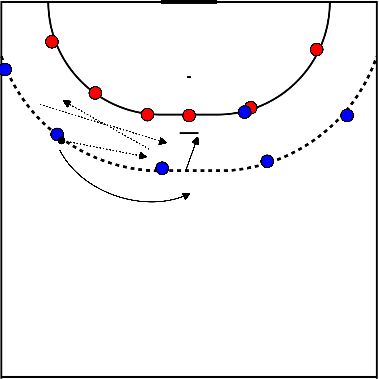
- A normal game is played, however with a special rule.
- Everything remains the same, teams of 7 (6 field players + 1 goalkeeper) are made.
- As a team in a break-out.
- In a first or in a second phase they make a goal they may attack again.
- If they have scored in this way they may break out again at the centre builder.
- If a goal is scored in this attack, they have made 2 points in 1 attack.
- If they don't score, it's only 1 point.
- This continues until time is up.
- Change:
- You can also choose to reward a break-out.
- You can also choose to reward a break-out, first or second phase attack with 2 points instead of a new attack.

- Condition exercise for sprint and turning speed
- There are about 6 pawns placed (seen from the back line at 3m, 6m, 9m, 12m, 15m and the middle line (20m)).
- All players start on the baseline.
- At the whistle, sprint to the first pawn,
- They touch the ground and sprint back to the back line (touch the ground here as well),
- Then the sprint to the 6m is started and everyone runs back and forth.
- Until you reach the 20m (middle line), then the exercise is finished.
- This exercise can also be done in pairs
- (The first runs to 3m, the second to 6m and the first again to 9m etc.).
- This exercise can also be done as a variation with a ball and with a dribble.
- You can then also choose to always run forwards or forwards and backwards.
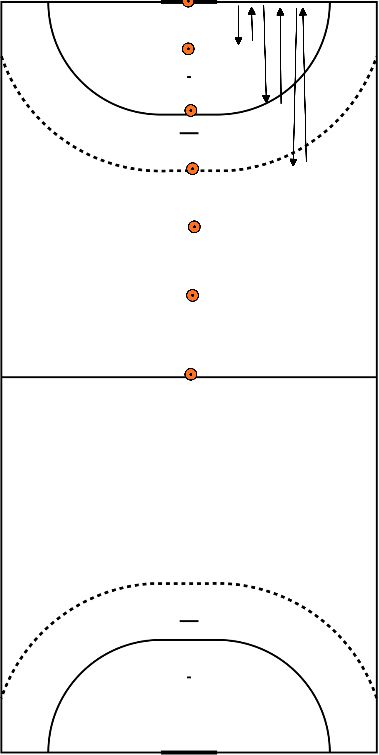
- All players are spread over the playing area.
- One player starts as the "hunter" and one player as the "prey".
- The "hunter" tries to catch the "prey".
- The "prey" can escape by running away or lying down next to another player.
- This player now becomes the "hunter" and the old "hunter" becomes the "prey".

- This exercise is shown for 3 groups.
- Each team does a different exercise.
- This is done to show the possibilities and variations.
- The passes are only shown on the way out.
- Players continue with passes on the way back to their starting position. (5-10 passes are possible).
- The 1st group plays side passes inside the pylons and turns to the outside around the pylons and then plays long passes on the way back.
- The 2nd group plays side passes on the right side of the pylons and both turn left around the pylons and then play side passes again on the way back.
- The 3rd group runs (dribbles) around the pylons.
- All passes are possible, but the exercise is best for the quick, precise side pass. Also a good exercise for training acceleration.
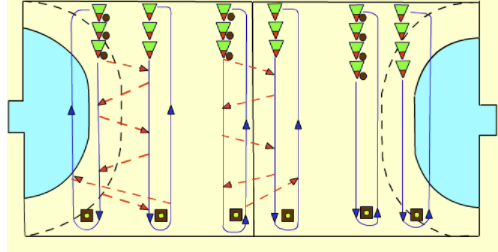
- Pairs stand in pairs in a large circle.
- In the middle are (number of pairs - 2) balls.
- On a signal the players start sprinting on the outside (remember to indicate the direction).
- When the player is back with his/her partner, she/he crawls between his/her legs and takes a ball from the middle.
- Those who have not conquered the ball must do some push-ups or something similar.
- Then they change places and start the game again.
- Variations:
- Sprinting with side steps
- Sprint backwards
- Sprint in different directions
- Lateral sliding passes to the left and right


- 2 teams of 5 - 6 players.
- The exercise is performed as a relay race.
- The team runs a slalom around the pylons.
- The point from which the throw must be made is at the pylon at the free throw line.
- The moment the player finishes, the next player starts.
- Variations:
- The whole round is dribbled
- Each player makes 3 rounds:
- The first round the ball is carried between the pylons and dribbled along the long side
- The last round is the whole round dribbled.
- Carry the ball between the pylons and dribble the rest of the way

- LH starts from the corner
- Goes by sliding passes to the left around the 1st pylon
- Then you go backwards around the pylon, which is on the free throw line.
- From there forward again to the circle and sideways to the left around the next pylon.
- Then go backwards around the pylon, which is on the free throw line. Etc.
- The next LH does not have to wait until the first one is on the right side,
- But he must wait until there is enough space so as not to bump into the previous LH.

- Players stand back to back facing the wall at a distance of 4 to 5 feet.
- The first player throws the ball and gets out of the way of the second player who has to catch the ball.
- Then the second player throws and the third player catches the ball, etc.
- Variation:
- Larger run distance for being back in line.
- Put the pawn behind the row formed, they must first go around it before they can join the row.
- The first player has the ball.
- The ball is thrown against the wall and the first player jumps over the ball with their legs spread wide.
- The next player catches the ball and throws it against the wall.
- The first player joins the back of the row. Etc
- The exercise can also be performed as a competition.
- In which case the player who cannot catch the ball or jump over it must disappear from the line.
